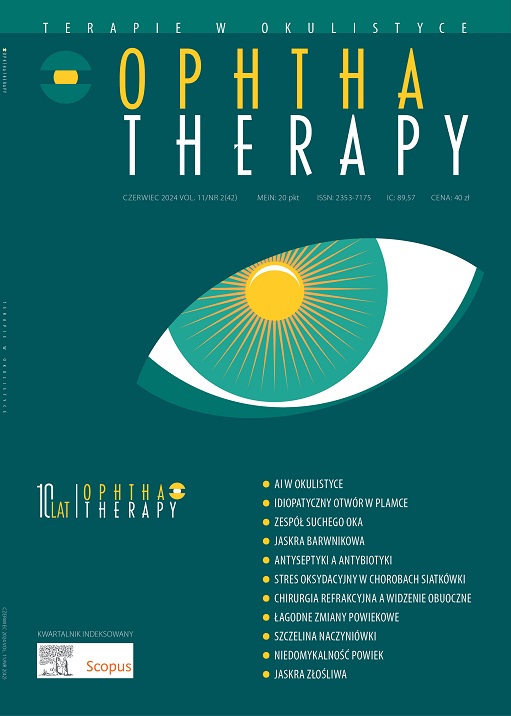Zespół suchego oka – problem współczesnych czasów Artykuł przeglądowy
##plugins.themes.bootstrap3.article.main##
Abstrakt
Zespół suchego oka to częste schorzenie okulistyczne wynikające z niedoboru filmu łzowego, prowadzące do dyskomfortu i uszkodzeń powierzchni oka. Zespół suchego oka dzieli się na trzy główne kategorie: ADDE (niedobór warstwy wodnej), EDE (nadmierne parowanie łez) oraz postać mieszaną. Diagnostyka obejmuje ocenę objawów klinicznych, testy laboratoryjne i wywiad z pacjentem. Leczenie zależy od przyczyny i nasilenia objawów, a obejmuje zastosowanie sztucznych łez, leków przeciwzapalnych, kropli z surowicy pacjenta oraz innowacyjnych kropli w formie mikroemulsji lipidowej. Te nowoczesne krople stabilizują film łzowy, chronią powierzchnię oka i wspierają procesy regeneracyjne, w efekcie zaś przynoszą pacjentom ulgę i poprawę jakości życia.
Pobrania
##plugins.themes.bootstrap3.article.details##

Utwór dostępny jest na licencji Creative Commons Uznanie autorstwa – Użycie niekomercyjne – Bez utworów zależnych 4.0 Międzynarodowe.
Copyright: © Medical Education sp. z o.o. License allowing third parties to copy and redistribute the material in any medium or format and to remix, transform, and build upon the material, provided the original work is properly cited and states its license.
Address reprint requests to: Medical Education, Marcin Kuźma (marcin.kuzma@mededu.pl)
Bibliografia
2. Dry Eye Syndrome – Preferred Practice Pattern – American Academy of Ophthalmology, Guidelines.
3. Thompson K, Brown S, Miller J. Dry eye syndrome: Comprehensive etiologies and recent insights. Int J Ophthalmol. 2022; 42(10): 3253-72. http://doi.org/10.1007/s10792-022-02320-7.
4. McCann P, Kruoch Z, Qureshi R et al. Interventions for dry eye: An overview of systematic reviews. J Ophthalmol. 2024; 142(1): 58-74. http://doi.org/10.1001/jamaophthalmol.2023.5751.
5. Verjee MA, Brissette AR, Starr CE. Dry Eye Disease: Early Recognition with Guidance on Management and Treatment for Primary Care Family Physicians. Ophthalmol Ther. 2020; 9(4): 877-88.
6. Messmer E. Pathophysiology of dry eye disease and novel therapeutic targets. Exp Eye Res. 2022; 217: 108944. http://doi.org/10.1016/j.exer.2022.108944.
7. Huang R, Su C, Fang L et al. Dry eye syndrome: comprehensive etiologies and recent clinical trials. Int Ophthalmol. 2022; 42(12): 3253-72. http://doi.org/10.1007/s10792-022-02320-7.
8. Versura P, Campos E. Menopause and dry eye. A possible relationship. Gynecol Endocrinol. 2005; 20(5): 289-98. http://doi.org/10.1080/09513590400027257.
9. Patel S, Mittal R, Kumar N et al. The environment and dry eye – manifestations, mechanisms, and more. Front Toxicol. 2023; 5: 1173683. http://doi.org/10.3389/ftox.2023.1173683.
10. O’Neil EC, Henderson M, Massaro-Giordano M et al. Advances in dry eye disease treatment. Curr Opin Ophthalmol. 2019; 30(3): 166-78. http://doi.org/10.1097/ICU.0000000000000569.
11. Giannaccare G, Taroni L, Senni C et al. Intense pulsed light therapy in the treatment of meibomian gland dysfunction: Current perspectives. Clin Optom (Auckl). 2019; 11: 113-26. http://doi.org/10.2147/OPTO.S217639.
12. Wang HH, Chen WY, Huang YH et al. Interleukin-20 is involved in dry eye disease and is a potential therapeutic target. J Biomed Sci. 2022; 29(1): 36. http://doi.org/10.1186/s12929-022-00821-2.
13. Chan HN, Zhang XJ, Ling XT et al. Vitamin D and ocular diseases: A systematic review. Int J Mol Sci. 2022; 23(8): 4226. http://doi.org/10.3390/ijms23084226.
14. Faulkner WJ. The role of omega-3 essential fatty acids in dry eye disease. Int J Clin Exp Ophthalmol. 2017; 1: 55-9. http://doi.org/10.29328/journal.ijceo.1001008.
15. Rao SK, Mohan R, Gokhale N et al. Inflammation and dry eye disease – where are we? Int J Ophthalmol. 2022; 15(5): 820-7. http://doi.org/10.18240/ijo.2022.05.20.
16. McCann P, Kruoch Z, Lopez S et al. Interventions for dry eye: An overview of systematic reviews. JAMA Ophthalmol. 2024; 142(1): 58-74. http://doi.org/10.1001/jamaophthalmol.2023.5751.
17. Chhadva P, Goldhardt R, Galor A. Meibomian Gland Disease: The Role of Gland Dysfunction in Dry Eye Disease. Review Ophthalmol. 2017; 124(11S): S20-6. http://doi.org/10.1016/j.ophtha.2017.05.031.
18. Roucaute E, Huertas-Bello M, Sabater AL. Novel treatments for dry eye syndrome. Curr Opin Pharmacol. 2024; 75: 102431. http://doi.org/10.1016/j.coph.2024.102431.
19. Mondal H, Kim HJ, Mohanto N et al. A Review on Dry Eye Disease Treatment: Recent Progress, Diagnostics, and Future Perspectives. Pharmaceutics. 2023; 15(3): 990. http://doi.org/10.3390/pharmaceutics15030990.
20. Bhujel B, Oh SH, Kim CM et al. Current Advances in Regenerative Strategies for Dry Eye Diseases: A Comprehensive Review. Bioengineering (Basel). 2023; 11(1): 39. http://doi.org/10.3390/bioengineering11010039.
21. Vickers LA, Gupta PK. The Future of Dry Eye Treatment: A Glance into the Therapeutic Pipeline. Ophthalmol Ther. 2015; 4(2): 69-78. http://doi.org/10.1007/s40123-015-0038-y .
22. Zhang X, Vimalin JM, Qu Y et al. Dry Eye Management: Targeting the Ocular Surface Microenvironment. Int J Mol Sci. 2017; 18(7): 1398. http://doi.org/10.3390/ijms18071398.

